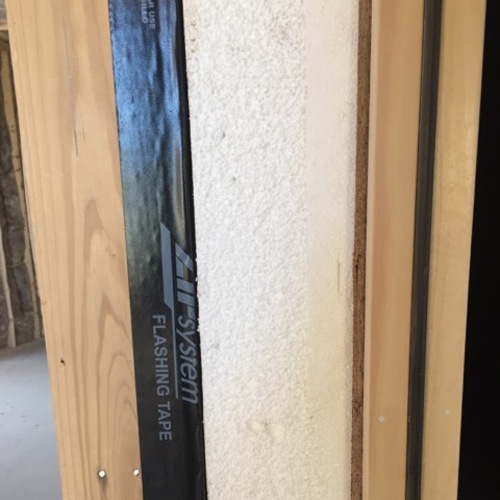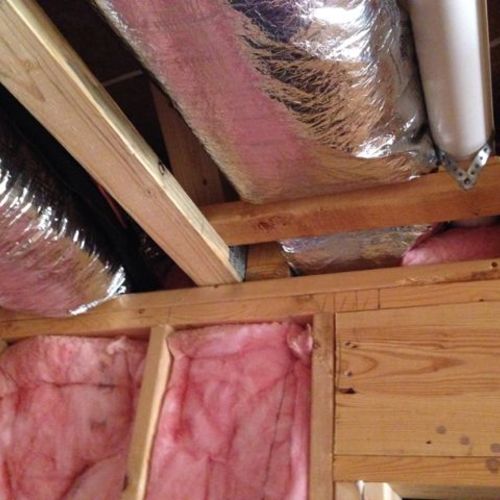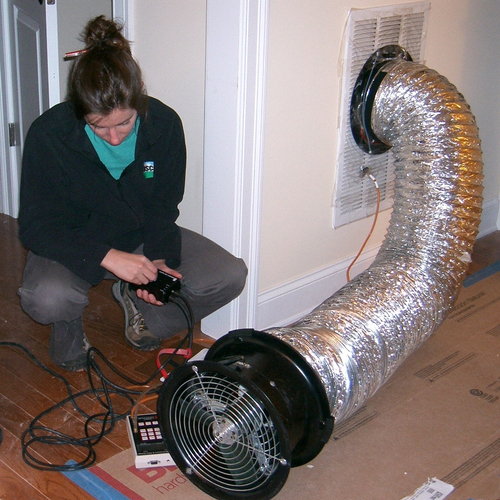Image Credit: All photos: Peter Yost
Image Credit: All photos: Peter Yost Building enclosure commissioning instructor Fiona Aldous whips up a quick sketch to demonstrate a key enclosure detail on one of her case studies. Fiona’s hand-drawn 3-D isometric details in the course materials were works of art. I could not resist taking this picture. As I was sitting at my desk writing this blog, I glanced up to see my “posted” BE Cx certificate just under my wingnut hat (essential gear for our Wingut Test Facility). Always important to maintain a balance and a sense of humor in one’s work…
I have been advising architects and builders on high-performance design, materials, and construction — particularly for residential buildings — for many years. But to do this work on commercial buildings, a building science training and credentialing program seemed really important (yet elusive).
This past November I bit the bullet and spent three days in class, a half day in exams, and several thousand dollars, and fulfilled the requirements for these two certifications:
- Building Enclosure Commissioning Process Provider (BECxP)
- Commissioning Authority + Building Enclosure (CxA+BE)
Huh? Just what the hell does that mess of acronyms really mean? Here are my key takeaways from the course, the exam, and the experience.
About commissioning
Commissioning (sometimes abbreviated “Cx”) is an owner-driven quality delivery process. It means representing the building owner’s interests in high performance, starting as early as the pre-design phase and extending into as much as one year of building operation.
Why commission?
- Commissioning reduces risk
- Commissioning proves that systems work at installation
- Commissioning lends validity to energy efficiency claims
- Commissioning improves durability.
Commissioning can be used for any size project, but realistically it is used primarily on larger (and longer) commercial building projects.
Commissioning is not inexpensive for the owner, but delivery of a higher-performing building with reduced rework, punch lists, callbacks, and defects can make it well worth it. The overall cost of a project can be less.
Commissioning is about guidance and verification of the quality process. The liability and responsibility for the project stays with the architect and engineer of record.
About the University of Wisconsin Building Enclosure Commissioning program and certificates
NIBS BE Cx? Some of us have been waiting a really long time for the National Institute for Building Science (NIBS) to come out with their Building Enclosure Commissioning (“BE Cx”) program, which will include training and certification. After all, the leading industry guide for BE Cx — Guideline 3 2012 — bears the NIBS name. But this has never borne fruit, despite the combined and integrated work of the National Institute for Buildings (NIBS), the ASTM E2813 working group, and the Building Enclosure Technology and Environment Council (BETEC).
The University of Wisconsin-Madison Department of Engineering BE Cx program remains the only real game in town and its stature grows accordingly.
About the course instructors and class
John Davis, PE, of UW-Madison’s Engineering Department administers the course and exams; he runs the ship. His work and background are in mechanical engineering — not building enclosures — so he heads up the introduction to commissioning, following and honoring the work of Chuck Dorgan (retired), who developed the course’s commissioning approach. John makes the course hum with his attention to detail.
Fiona Aldous, principal with Wiss, Janney, Elstner Associates, takes the lead when it comes to teaching about the building enclosure commissioning process. An architect by training, Fiona is a prime author of NIBS/ASHRAE Guideline 3 – The Building Enclosure Commissioning Process , the guidance document for building enclosure commissioning. Fiona is an awesome instructor and lends critical field experience to the course content.
Joseph Lstiburek, PE and PhD, a principal of Building Science Corporation, lays the building science foundation for the course. He is introduced as the “North American Dean of Building Science.” It just does not get any better than Joe.
Peter Adams, principal with Morrison Hershfield, takes the lead on the topics of field and lab testing of building enclosures. He is wicked smart, unassuming, and brings the testing element of building enclosure commissioning to life.
About the elements of building enclosure commissioning
What’s driving building enclosure commissioning?
- LEED V4 (October 2016) – A prerequisite called Fundamental Commissioning & Verification includes a requirement for design review of the building enclosure. It also mentions building enclosure commission in both the Owner Project Requirements (OPR) and the Basis of Design (BOD), and references ASHRAE Guidelines 0 (Cx) and ASHRAE Guideline 3 (BE Cx).
- ANSI/ASHRAE/USGBC/IES Standard 189.1-2011 – This standard requires commissioning for any building over 5,000 square feet and includes these systems: Building Envelope Thermal, Moisture, and Pressurization.
- IGCC – 2012 – Chapter 9 is on Commissioning, Operation, & Maintenance; section 903.1 – Construction or system requiring verification includes: vegetative roofs, subsoil drainage, foundation dampproofing, flashings, and exterior wall coverings.
NOTE: According to Fiona Aldous, 189.1 and IGCC are to merge into one document in the next few years.
Paying attention to details and overseeing performance testing
MasterSpec Section 01 91 19, Building Enclosure Commissioning, is based on ASHRAE Guideline 3 and weaves review of details in with review of specs.
Building enclosure commissioning in the pre-design phase focuses on defining project expectations. The focus switches to quality assurance in the design phase, moves to quality control and verification during the construction phase, and extends to owner training and maintenance in the occupancy and operations phase.
Building enclosure commissioning requires reviewing all details and identifying missing details.
Building enclosure commissioning includes a review of all mock-ups and submittals; job site quality management of construction details may involve a variety of checklists, including custom, sequential, or construction checklists.
Types of performance testing can include: air infiltration, water penetration, water absorption, condensation, thermal performance, accelerated aging, adhesion, anchor pull-out, infrared thermography, and whole building airtightness.
If the people in charge of commissioning can’t be at the job site at critical stages of construction, they should set up training sessions ahead of time to ensure that the details get done right.
Final takeaways
With an experienced integrated project team, building enclosure commissioning can be just a part of the high performance process; if the project team lacks either experience or integration, building enclosure commissioning can be an ugly and frustrating babysitting nightmare.
It’s the custom and singular nature of building that leads to project complexity, lack of uniformity, and failure to take advantage of lessons learned. These facts ultimately elevate building enclosure commissioning to a mandatory element of high-performance buildings.
In addition to acting as GBA’s technical director, Peter Yost is the Vice President for Technical Services at BuildingGreen in Brattleboro, Vermont. He has been building, researching, teaching, writing, and consulting on high-performance homes for more than twenty years. An experienced trainer and consultant, he’s been recognized as NAHB Educator of the Year. Do you have a building science puzzle? Contact Pete here. You can also sign up for BuildingGreen’s email newsletter to get a free report on avoiding toxic insulation, as well as regular posts from Peter.
Weekly Newsletter
Get building science and energy efficiency advice, plus special offers, in your inbox.
















7 Comments
Please expand
Interesting, thank you. Other than mock-ups, could you please expand on how you test and verify a very large building, specially water penetration, water absorption, condensation, and anchor pull-outs? I hate to be the one climbing on a ladder 50 stories high ;-))
Spec. creep
Thanks for this, Peter. Like you, a building envelope commissioning training/certification has been on my list for a while. Will look int this in more detail. Because the BE consultant carries liability for envelope failures, there seems to be a tendency for all envelopes to tend towards the ultimate, no matter the specific climate and exposure conditions. Any thoughts on the BE CxA's role in finding balance between the OPR and the BEC's desire to protect their insurance premiums?
Building in photo is private development
Hi Peter,
Interesting article, I'll pass it along to my colleagues in multifamily and commercial here at Madison Gas and Electric.
I'm almost certain the building in the photo isn't owned by the University. Private apartment complex, if memory serves.
Building in photo is private development
My mistake Jonathan - not sure why I claimed to know how building this was under construction. I am editing the caption accordingly. Thanks.
Spec creep
Interesting question Alistair.
But to be clear: the Commissioning Provider (CxP) only advises and verifies so that the liability is entirely on the Architect on Record, the Engineers on Record, and the General Contractor. As an agent of the Owner, the CXP is a Quality Assurance/Quality Control leader.
In terms of the BE consultant legal liability: In my opinion, this depends on the contractual relationship with whom the BE is consulting. In my BE consulting, we make it clear that the ultimate responsibility lies with the Architect and the Builder and so the best way to reduce everyone's liability is to have a good QA/QC program, or BE Cx!
Please expand: performance testing on really big buildings
I have never worked on a really big building Armando so I am assuming that performance testing for water penetration and the like is done with the help of really big cranes or cable window-washing platforms rigged from the top of the building.
I have seen large lulls being used to do enclosure testing but no 50 story buildings, of course.
Water Testing Big Buildings
Yeah, that's pretty much the deal. The tester rigs up an interior depressurization rig (typically a mask covering a window with a vacuum system), and sprays from the exterior (e.g., spray rack on a boom lift). The testers who do this work are consultants who repeat these types of tests, day-in, day out. The test specification to look for is an AAMA 502 (windows) or 503 (storefront, curtain wall, skylight) test.
Log in or create an account to post a comment.
Sign up Log in